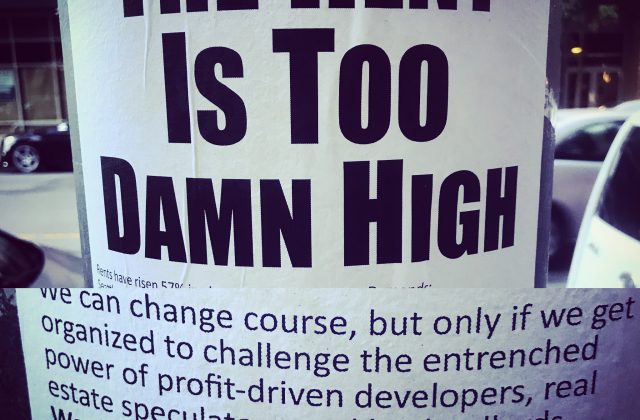Full Disclosure? City’s Responses on MHA Questions More Peculiar than Helpful
We’re in the early stages of putting together a legal challenge of the City’s version of Mandatory Inclusionary Zoning (MIZ) called Mandatory Housing Affordability. The case may well rest on the most obvious of economic and legal questions, “How does new housing create an impact to the City by causing housing prices to go up,” and “How is the City’s fee schedule proportionate to this claimed impact?” It is going to be hard for the City to prove that more housing makes it more expensive and maybe even more difficult to show how charging a project in Greenwood $20 a square foot is a rational fee and not just a tax for subsidized housing. As part of this I asked the City to please share with me what projects have paid fees under the program and how much additional development capacity those projects received in exchange. Here’s the first response:
I wrote about this response already. The implication here is that there is no value exchange for the fee, a bit of a slip that City staffers realize that practically speaking MHA is just a tax on development. Oh, I mean “contribution” for non-profit housing developers extorted by the City through the land use code.
What about the fees?
At the roughly $375,000 per unit it now costs to build non-profit housing, that’s about 4 units. The projects range from, top to bottom, a 100 plus apartment building at 23rd and Union, an upzone from 40 feet to 65 feet in Fremont for apartments, and a church project in West Seattle that was a rezone and paid a lot more fees that it should have, a upzone for an 85 unit apartment building.
As for the church project, the West Seattle Blog story I link to says it all:
The church says it would be charged $200,000 in MHA – to fund “affordable housing” somewhere else. That’s more than a quarter of the revenue it estimated the project would bring. A list of its concerns distributed at the October MoCA meeting includes: “These fees come straight out of the bottom line of the project. Every penny that we pay the city for MHA is one we don’t have to restore the church and build the playground.”
In this case the City’s muscle shook down a church for $200,000. Good work.
How about the difference between what’s going on at 23rd and Union and 1600 Dexter. The folks at Dexter should be scratching their heads and dialing their lawyers. Why is their project paying $1.3 million while a larger project in one of Councilmember Lisa Herbolds “low opportunity” neighbors is paying $60,000? When I first saw that figure, I had to clean my glasses. No, I wasn’t missing any zeros: $60,000. I’ve sent in yet another Public Disclosure Request (PDR) for the “development agreement” that prevails at that address. We’ll see.
As for the apartment project in Fremont, it looks like the typical project that will often be exposed to MHA exaction. Again, we haven’t had the time to dig into this and since the City won’t respond to anything but PDRs, we’ll just have to keep asking questions and waiting for responses. I’ll also reach out to the developers. But not much housing is going to be built by non-profits with fees amounting to $37,000. I’m not asking for higher fees, but part of the economic and legal case the City will have to make is how and why such a hap hazard fee schedule has any sort of relationship to the stated impact and the solution.
One thing is clear, however, and that is that in the era of Mayor Durkan the only answers that can be found from the City are through a formal disclosure process. E-mails and requests for discussions on costs and other recommendations from the Housing Affordability and Livability Agenda (HALA) Committee go unanswered. I find is somewhat vindicating, but not consoling, that people who bet on Durkan are now telling me that she “doesn’t like developers.” That’s funny.
My criticism of the then new Mayor was why some people turned on me so hard after the election. “Give her a chance!” But she’s had more than six months on the job and has shown she’s pretty much a ribbon cutter, showing up to events, making speeches and pronouncements, and then moving on. She hasn’t figured out the job. Part of that job is learning what you don’t know, being humble and listening to people who do. It’s Ed Murray’s second term with all the stubbornness and lack of sensitivity to what’s happening day to day in the city. Will that change? Can it change? Maybe that’s my next Public Disclosure Request.
New Campaign Ad Asks: “Where did all the money go” for Housing on the Peninsula?
The Rental Housing Association of Washington has taken out a radio advertisement asking the question I’ve been asking too: “where did all the housing money go that should have been helping people in need in Aberdeen?” I did a post on this question and compared how much housing could be built in Aberdeen, in Grays Harbor County with the money being used for Building 9 in Magnuson Park. It could buy a lot, more than 25 percent of the 2,000 units local activists are calling for. But Speaker Frank Chopp is a big advocate for Building 9, getting Tharinger to put in a $2,500,000 allocation for the project; zero for Grays Harbor County.
Here’s the ad:
And is there need in Grays Harbor County? There is, and the housing situation is worse in Grays Harbor than it is in King County. I’ll post the numbers I sent Senators Palumbo and Mullet this weekend.
| Grays Harbor County | King County | |
| Poverty | 16.60% | 10.70% |
| Area Median Income | $48,517 | $84,897 |
| 60% AMI Hourly | $14.00 | $24.49 |
| Unemployment | 6.50% | 3.40% |
| Food Assistance | 22% | 8% |
| Housing Production* | 11.6 | 2.7 |
| Housing built before 1980 | 65% | 53% |
| Housing Trust Fund (2008 to 2018) | None | $130,038,755 |
* Number of residents per units produced (OFM)
Maybe Representative Steve Tharinger, the Chair of the House Capital Budget Committee, has an explanation. After all, it is his committee that gave out about $100 million in housing money but not a dollar to his own district. So where did all the money go? Looks like a lot went to King County and Seattle.
Wanted: Bi-Partisain Effort to Reform Housing in Washington State
This is my email to State Senator Guy Palumbo and State Senator Mark Mullet who wrote an important opinion editorial in the Seattle Times over the weekend. I’m hoping their join our reform efforts not for more and more and more money, but sensible, fair and efficient reforms. Palumbo and Mullet are Democrats. Will they work across the aisle on this issue? We’ll see. Up to this point, only Republicans seem to understand the problem, too many rules and fees and taxes, and the solution, fewer rules and fees, and taxes on housing.
Dear Senator Palumbo and Senator Mullet,
Thank you for your opinion editorial in the Seattle Times.
The solution for housing scarcity is certainly not taxing jobs. Thank you.
But what is the solution? More money?
Since 2008, Housing Trust Fund (HTF) projects have built 9655 units at a cost of $2,060,894,710. The HTF funded $599,496,831 of those construction costs, about 17 percent. The average project over that time had about 39 percent of its funding from the HTF, the rest coming from other sources including Low Income Housing Tax Credits (LIHTC).
Over that period, King County received about $130 million of the HTF allocation, about 31 percent and Seattle received about $61 million or about 17 percent. This trend has continued, with urban areas receiving $40 million from the HTF with half of that going to King County. Very little, about $4 million went to home home ownership programs. Meanwhile, rural Washington got $17 million from the HTF about 30 percent.
What’s going on?
Some would argue that since population is concentrated in King County it should get a third of the funding. But consider where the greatest housing needs in the state can be found. That need is in rural Washington. Consider Grays Harbor County.
As I have been doing research on the disparity of the distribution of HTF dollars I’ve been looking at years of data, including top line numbers on Grays Harbor compared to King County.
| Grays Harbor | King | |
| Poverty | 16.60% | 10.70% |
| Area Median Income | $48,517 | $84,897 |
| 60% AMI Hourly | $14.00 | $24.49 |
| Unemployment | 6.50% | 3.40% |
| Food Assistance | 22% | 8% |
| Housing Production* | 11.6 | 2.7 |
| Housing built before 1980 | 65% | 53% |
| Housing Trust Fund (2008 to 2018) | None | $130,038,755 |
* Number of residents per units produced (OFM)
I hope you have the patience to stick with me here. So what’s going on?
Housing in Seattle and King County is getting more and more expensive. Over this 10 year period per unit costs have gone up in Seattle from about $221,000 per unit to about $369,000 per unit. One project in Seattle proposed by Plymouth Housing will build and open 84 studio apartments at 501 Rainier sometime in 2021 for a total cost of about $31,000,000 or about $369,000 per unit. A rehabilitation project at Magnuson Park, Building 9, in Seattle will create just 148 units, someday, for $73,000,000 or about $493,000 per unit. Here’s what I wrote about Building 9 and Grays Harbor County:
For scale, consider that the passed and then repealed tax on jobs would have raised about $47 million per year, about two-thirds of the cost of this one project. Another stick to use would be my analysis of housing on the Peninsula where over the last ten years housing paid for by the Housing Trust Fund averaged about $120,000 per unit. For $73,000,000 that would mean about 608 units in Grays Harbor County, enough to reach more than 25 percent of the 2,000 units local activists are calling for there.
Why are these costs rising so rapidly in Seattle and urban King County? Here are the words of a board member of the Capitol Hill Housing Improvement Program, known as CHIP, expressing frustration over my relentless criticism of their rising costs:
A lot of people focus on numbers, but we should focus on value of our buildings, including their sustainability and their effect on the community. Rob mentioned that to the extent that there are cost differentials, we could give examples of why it might be more expensive and that those things should be changed (ie government regulations). Rob proposed that comparing market rate and affordable housing is like comparing apples and oranges (emphasis is mine).
Yes, I admit it. I focus on numbers. Numbers aren’t Republican or Democratic. You can compare apples and oranges, they are both fruit, and the apples in Seattle are a lot more expensive than the oranges in Grays Harbor County. The reason is overregulation. Even powerful non-profit housing developers, in meetings they think are private, agree with the people I work with in market rate housing: there are too many rules.
But here’s another number: 26,000 households. This is the number touted as those households at 30 percent of Area Median Income (AMI) that are “cost burdened,” a term you reference in your editorial. Those households earn about $20,200 per year, and should pay about $500 a month for housing. If they pay 50 percent, the typical definition of cost burdened, they are paying about $840, a difference of about $300. If we just gave cost burdened households $300 a month (I think the 26,000 number is way too high) it would cost about $93,000,000. The total cost of building non-profit subsidized housing in Seattle averaged about $60,000,000 a year, probably a conservative number.
The point is that we could eliminate most if not all the cost burden for people who already have housing, with cash. Why would we spend $9,594,000,000 — 26,000 X $369,000 — to build those households units, years from now? We wouldn’t. That would be irresponsible. And it would not be compassionate, fair, nor efficient. Programs like the Multifamily Tax Exemption (MFTE) program could pass on modest tax reductions to new and existing housing (if your colleague Speaker Chopp would allow it!) to substantially reduce an eliminate cost burden with rent restrictions. Taken together, these tax reductions and direct cash subsidies could wipe out cost burden by the end of next year. This would also prevent many households from missing rent payments and falling into homelessness.
Back to the powerful non-profits.
Why don’t they work with us to eliminate those, lower the cost of market rate housing which would lessen demand for subsidies and allow them to build more units and house more families? See above. The legislature is all to willing to find more and more and more money. And that’s where I depart from you both. We don’t need more money. Really. We don’t. We don’t need imaginative or new taxes or sources of revenue. We don’t. We need fewer rules and a more efficient and fair system of using the subsidies we have.
Please work with us to stop the relentless search for revenue, find ways to reduce barriers to production, and produce a more fair, efficient, and compassionate system of solving the state’s housing issues. People are suffering in rural Washington while the non-profits in Seattle are doing nothing to hold the Seattle City Council and Mayor accountable. Every bad land use and housing decision by Seattle, like taxing jobs, illegal mandates for inclusion and fees, and now impact fees, means higher hurdles for housing there, more demand for money and fewer dollars for other people in the state. Now they are coming to you for even more money. Don’t forget that Seattle’s Mandatory Housing Affordability (MHA) program is an extortionary scheme that will raise prices and is illegal under state law (see especially RCW 36.70A.540(c) and RCW 82.02.020); we’d urge bipartisan to preempt cities in Washington from Mandatory Inclusionary Zoning.
Again, numbers aren’t Republican or Democrat. Are you willing to work across the aisle to fundamentally reform this system? I am ready to meet and work with you anytime (see attached). Senator Warnick has taken leadership on this issue. And next session, no matter what happens at the ballot box, I believe we can do this, together, in 2019 in the Senate. I’ll repeat the chorus of your article in the Seattle Times:
We need to think creatively to find results-driven solutions. We also need to work collaboratively with the business community to ensure that whatever solutions we pursue work for all concerned.
Above all, one thing is clear: Doing nothing and allowing this crisis to worsen is not an option.
Amen!
Roger–
PS — All my numbers are evolving based on ongoing research and public disclosure requests. I believe the Joint Legislative Audit and Review Committee’s work on this topic will help give a better understanding of non-profit costs. We are also doing our own study using a consultant.
Attachments: Housing Reform Ideas and Grays Harbor County 10 Year Plan to End Homelessness
In San Francisco: A Brief History of Seattle’s Slide Away From Supply Side Solutions
I wrote at Forbes about my first take at a 5 to 7 minute presentation at a housing conference in San Francisco. I’ve been traveling and on the move, so I didn’t have an opportunity to post this yesterday, but this is more or less what I said at the conference. The organizers wanted me to give people an update and sense of what is happening in Seattle. This was my second take.
In 1989 the Washington State Legislature passed the Growth Management Act (GMA) a comprehensive reform to state planning and land use law that mandated that future growth would take place in urban areas and investment in infrastructure would follow. The GMA was an effort to staunch the flow of population and housing into sprawling acres of single-family homes subsidized by miles of highways. Seattle, like all urban areas, was required to develop a comprehensive plan. Seattle’s idea was Urban Villages – a compromise with single-family neighbors who, to this day, occupy about 65 percent of land in Seattle. New growth would flow into areas already zoned for density, and like a microcosm of the state’s plan, so would infrastructure and amenities. Single-family zones would remain untouched.
Through the 1990s neighborhoods were given resources to discuss how –not whether – growth would happen and they developed neighborhood level plans. This made the process a success, turning many angry neighbors who folded their arms into advocates for their neighborhoods, pushing for amenities and improvements while accepting growth and development. And the City kept its promise, allocating and prioritizing resources to Urban Villages. But this all ended with the election of a new Mayor and the recession in 2001. The process disbanded, and growth slowing, neighbors and the City disconnected, and a top down approach followed.
With the Great Recession of 2008 and subsequent recovery, something happened that we’re still living with today: the formation of an unusual axis between single-family neighbors benefiting from increases in housing prices because of housing scarcity, and socialists emboldened by the financial crisis of 2008 who viewed market rate housing as a corporate venture intended solely to profit from selling a necessity. What these groups share is a relentless opposition to the production of market rate housing.
The neighbors oppose new housing because they fear change that will affect the value of their investment, knowing that more supply would mean lower prices. They don’t say this, but instead offer a litany of red herrings: Parking, design, construction noise, view blockage, loss of tree canopy, loss of bird habitat, the size of units (too big or too small), traffic, building materials, fenestration, and many others are all reasons to slow and stop new construction.
The socialists oppose new housing because any increase in production will result in more profits –and they’ve made it clear that they oppose new profitable housing ventures even if they result in lower prices. As Margaret Thatcher once said of socialists, they’d rather that the poor were poorer provided the rich were less rich. Seattle’s socialists argue that housing is a human right, ignoring, of course that if rights are scarce, they will be expensive too That is, in a socialist paradise in which there are fewer housing units than people that need them, high prices set by an impersonal supply and demand dynamic will be replaced with rationing from a political and centralized bureaucracy, a perfect example of Hayek’s Road to Serfdom.
When the economy began to boom in 2011, so did demand for and construction of housing. Since then and now, these two groups have been successful in suppressing many things that worked: small-lot infill development in single-family neighborhoods, microhousing, reducing the density of and blocking small retail use in Seattle’s efficient low-rise zones, challenging back yard cottages, and limiting the City’s tax exemption program to incentivize rent restricted housing. All of these had the effect of reducing single-family housing in single-family zones, killing higher density microhousing that allowed lower rents in multifamily zones, and reducing participation from market rate developers in a program that created thousands of rent restricted units in market rate buildings at a 20 percent inclusion rate, a program called Multifamily Tax Exemption or MFTE.
Finally, the City has begun an aggressive effort to tax housing – which will slow production and raise prices – to funnel money from the market into the production of non-profit housing through Mandatory Inclusionary Zoning. This policy is so obviously inflationary that one can only slap one’s forehead in disbelief that it is being offered as a “solution” to the problem of price. It’s the classic technique of burning down the village to save it.
All this culminated earlier this year with a failed effort to tax jobs too, in order send more money to non-profit housing developers.
What’s wrong and what’s the solution? All of us have to remember that the proper formulation is not, “We need more affordable housing,” but “We need more housing so that it is affordable.”
We simply must push for dramatic and sustained deregulation of the housing market, and keep only those regulations that preserve or improve health and safety. For households that don’t have enough income to pay rents that off set the costs of land, construction, financing and operation of housing, we should provide direct cash assistance for rent, provide tax abatement in exchange for rent restrictions, and only for high utilizers of social safety net programs, capital investment in new construction of non-profit housing.
There are a lot of good ideas about how to make cities more affordable and accessible to people of all levels of income. But unless and until we tackle these two powerful groups, the intellectual effort is wasted. We need to invest in conditioning the discourse to appeal to people’s innate understanding of fairness and scarcity and push back on single-family neighbors who are truly the ones who profit from scarcity and socialists sentimentality and utopianism. We’re either in this to solve the problem or make people happy – we can’t do both.
Rent Control: Rising Rents are a Signal We Need More Housing, Not More Rules
Housing, like food, is important not just for survival but also for expanding opportunity for people of all levels of income. When housing is scarce, people with fewer dollars to spend feel the downsides of lack of housing supply the most. Those families see a greater and greater share of their incomes consumed by housing costs. And those families are disproportionately people of color, seniors on fixed incomes, and others who have limited ability to earn more money.
Rents go up when supply does not keep up with demand. If bread was in short supply, and lots of people wanted it, there is no doubt that price for bread would –as the press loves to repeat – “sky rocket.” When prices rise poor people suffer. The solution is to bake more bread. The same is true with housing. When production rises to meet and even exceed demand, then developers and landlords compete with each other instead of tenants or buyers competing with each other for limited housing products. We need more housing so that it will be affordable.
Rising rents don’t cause homelessness; rising rents are a symptom of housing scarcity. Lack of adequate housing supply is a cause of homelessness. A recent Seattle Times article showed that rent increases are slowing and, in fact, many new buildings are offering concessions, essentially lowering rent, because there are more options for consumers. More building has created this opportunity, not controls on rent or housing prices.
Make no mistake SB 6400 is a rent control measure. While advocates suggest that it is simply a local control bill, aimed at allowing local jurisdictions access to price controls that they don’t now have. Seattle will impose rent control. They’ve already passed a resolution saying so, and Seattle’s actions will encourage others.
Rent control, like all price controls, assumes that landlords set average rents. They don’t. Market dynamics – supply and demand – determine price. Think for a moment: if a land lord wanted to get rich quick, why wouldn’t she set her prices at $10,000 a unit? People couldn’t pay that price, right? So she’d keep lowering her price until someone was able to pay. That’s how it works. Landlords can only charge what people can pay and they have to generate enough revenue from rent to pay for operating expenses.
Rent control will limit and distort supply be creating disincentives to build new housing and to spend more money to maintain and improve existing housing. If rent controls are imposed, landlords will have not choice but to keep their rents as high as possible just to operate their buildings, and making improvements won’t be an option. And investors would avoid new housing because of the risks of getting a return on their investment.
There are alternatives. We can help buy down existing cost burden with direct cash payments to help with rent. We can create more rent restricted housing with tax exemption programs like the one in Seattle that has created thousands of rent restricted units. And we can support low interest loan programs to help landlords maintain older buildings so improvements don’t get passed on in the form of higher rents. And it makes more sense to use subsidy dollars to simply give people money to help pay their rent.









